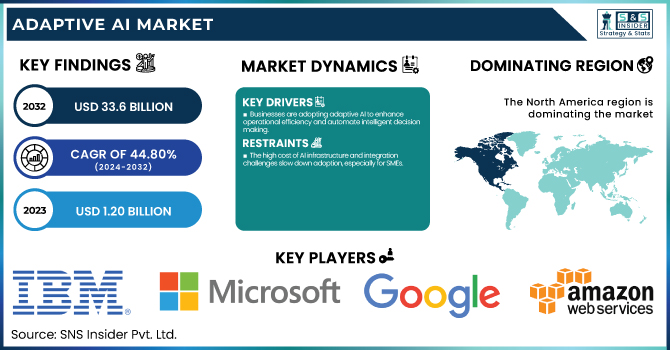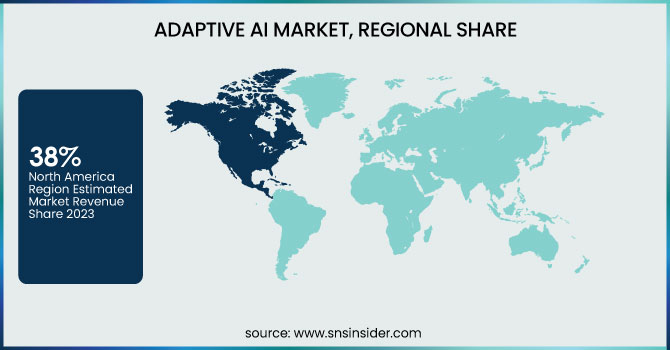Adaptive AI Market Report Scope & Overview:
The Adaptive AI Market was valued at USD 1.20 Billion in 2023 and is expected to reach USD 33.6 Billion by 2032, growing at a CAGR of 44.80% from 2024-2032.

To Get more information on Adaptive AI Market - Request Free Sample Report
In 2023, model training efficiency saw notable improvements with advancements in AI algorithms and hardware acceleration, cutting computational costs. User adoption surged as businesses embraced adaptive AI for automation and personalized experiences. Its impact on business automation was significant, facilitating real-time decision-making and streamlining workflows across various industries. Additionally, AI decision-making accuracy improved through continuous learning and contextual adaptation, enhancing predictive analytics and overall operational efficiency.
Adaptive AI Market Dynamics
Drivers
-
Businesses are adopting adaptive AI to enhance operational efficiency and automate intelligent decision-making.
Adaptive AI is growing in popularity by needing real-time, data-driven decision-making to improve operational efficiency on the go. AI models that can learn continuously and adapt to dynamic environments are gaining wide adoption across domains – from finance to healthcare and e-commerce. The capacity to analyze massive data sets and provide real-time insights allows the organizations to streamline processes, minimize downtimes, and enhance customer experiences. Also, the global technological shift towards IoT, and connected devices creates more opportunities for AI automation, thus adaptation AI is synergistic with intelligent decision making. Self-learning AI models will continue in demand for the better part of the next few years as enterprises are giving high importance to agility and responsiveness.
Restraints
-
The high cost of AI infrastructure and integration challenges slow down adoption, especially for SMEs.
While adaptive AI comes with its perks, challenges such as high costs for implementation and difficulty to integrate are stalling the widespread adoption of this type of AI. Creating and sustaining adaptive AI systems relies significantly on advanced computation resources, talented individuals, and regular improvement of the algorithms that underlie these systems. Such advanced AI-based solutions come with a price tag which makes it difficult for small and medium enterprises to even think of such resource utilization. Furthermore, embedding adaptive AI into current workflows requires tight interoperability with legacy systems, which can be both time-consuming and costly. Such fiscal and infrastructural hurdles could delay adoption — particularly in cost-sensitive or regulatory-heavy sectors.
Opportunities
-
Cloud-based AI solutions and improved machine learning frameworks are making adaptive AI more accessible.
The fast pace of AI and cloud computing evolution represents huge opportunities for the adaptive AI market. Cloud AI solutions offer scalable, pay-as-you-go infrastructure that enables businesses to deploy adaptive AI models without requiring extensive in-house resources. An abundance of key players in this field: The biggest tech companies are pouring immense resources into AI-as-a-service platforms, democratizing access to adaptive AI for more industries. Furthermore, optimization of machine learning frameworks, edge AI and federated learning improves the adaptability of AI while preserving data privacy and security during applications. Expect innovations and increased adoption of adaptive artificial intelligence, made possible by these advances in technology.
Challenges
-
Ensuring fairness, transparency, and compliance with evolving AI regulations remains a significant challenge.
Ethical and regulatory concerns are the single largest adoption challenge for adaptive AI. With the constant evolution of AI models, it becomes more and more challenging to maintain transparency, fairness, and accountability. Regulators and stakeholders are concerned about issues such as bias in AI decision-making processes, data privacy, and potential misuse of AI-driven automation. Across the globe, governments are tightening their AI regulation, putting organizations under pressure to adhere to ethical AI frameworks and data protection laws. The balancing act between adapting AI and enforcing compliance to that adaptability is a daunting task for businesses. The growth of the market will depend on answering these concerns with responsible AI practices and transparent model governance.
Adaptive AI Market Segmentation Analysis
By Component
In 2023, the platform segment dominated the market and accounted for 61% of revenue share, Adaptive AI platform refers to a sophisticated tier of automation that combines dynamic and adaptable learning abilities in artificial intelligence. It integrates advanced machine learning and deep learning methods with traditional AI methods to create systems that can be constantly adapted and evolved. The core property of an adaptive AI is its ability to learn continuously, evolving and improving its capabilities by interacting with users and data. It can adjust its models, algorithms and strategies based on real-time input and changing dynamics. It is especially suited for applications where parameters are unsighted and data is dynamic, which makes it one of the most flexible algorithms.
By Application
In 2023, offline learning and adaptation segment dominated the market and accounted for the greatest revenue share. This ability to learn and adapt offline is critical for an adaptive AI system as it enables the system to continue to improve even without human interactions or real-time data sources.
The real-time adaptive AI segment is expected to register the fastest CAGR throughout the forecast period. Adaptive AI systems are designed to learn from new data and experiences as they happen in real-time. They might improve their performance, update their knowledge, and refine their models in real-time. This is a critical feature for real-time applications such as financial trading, weather forecasting, and autonomous driving where data changes continuously.
By Technology
In 2023, the deep learning segment dominated the market and accounted for significant revenue share. These deep learning algorithms are capable of automating high-volume, but low-value tasks more efficiently than humans. In addition, they can also ensure the quality of the work and offer added values, such as key insights. So, using deep learning can save time and money for organizations, allowing them to later be able to move workers to creative action that can most benefit from the human touch. Hence, deep learning is disruptive technology for numerous end-use industries, driving the growth of technology in the forecast period.
Regional Landscape
North America led the adaptive AI market, generating over 38% of revenue in 2023. There are a variety of uses of adaptive AI in healthcare, especially in North America. Adaptive AI allows hospitals and other medical facilities to use personalized treatment plans, predictive analytics, and real-time patient monitoring. Technology also allows physicians and other health care providers to constantly adjust diagnosis and medical treatment based on discoveries in the medical field and specific patient information. In addition, Adaptive AI powers most of North America's Robots, Drones and Autonomous Vehicles.
Asia Pacific is expected to register the fastest CAGR during the 2024 and 2032. Adaptive AI is entering into other omnipresent sectors in the Asia Pacific area, which are now powered to keep innovating aggressively. The market is being driven by numerous aspects such as research and development projects, an eye for high tech markets, a continuously advancing digital topography and attention to AI-oriented solutions.

Get Customized Report as per Your Business Requirement - Enquiry Now
Key Players
The major key players along with their products are
-
IBM Corporation – IBM Watson AI
-
Microsoft Corporation – Azure AI
-
Google LLC – Google Cloud AI
-
Amazon Web Services (AWS) – AWS AI Services
-
NVIDIA Corporation – NVIDIA AI Enterprise
-
Intel Corporation – Intel OpenVINO
-
SAP SE – SAP AI Core
-
Oracle Corporation – Oracle AI
-
Siemens AG – Siemens Industrial AI
-
Cisco Systems, Inc. – Cisco AI Analytics
-
Salesforce, Inc. – Salesforce Einstein
-
Meta Platforms, Inc. – Meta AI
-
Hewlett Packard Enterprise (HPE) – HPE Ezmeral AI
-
Accenture – Accenture AI
-
C3.ai, Inc. – C3 AI Suite.
Recent Developments
-
January 2024: NVIDIA launched the GeForce RTX 40 SUPER Series graphics cards at CES 2024, designed to enhance AI-powered PCs and supercharge the latest games.
-
February 2024: Google DeepMind released the Gemma collection of open-weight large language models, available in 7 billion and 2 billion parameter models, optimized for various applications.
-
March 2024: DeepMind introduced the Scalable Instructable Multiword Agent (SIMA), an AI agent capable of understanding and executing natural language instructions across diverse 3D virtual environments.
|
Report Attributes |
Details |
|
Market Size in 2023 |
USD 1.20 Billion |
|
Market Size by 2032 |
USD 33.6 Billion |
|
CAGR |
CAGR of 44.80% From 2024 to 2032 |
|
Base Year |
2023 |
|
Forecast Period |
2024-2032 |
|
Historical Data |
2020-2022 |
|
Report Scope & Coverage |
Market Size, Segments Analysis, Competitive Landscape, Regional Analysis, DROC & SWOT Analysis, Forecast Outlook |
|
Key Segments |
• By Component (Platform, Services) |
|
Regional Analysis/Coverage |
North America (US, Canada, Mexico), Europe (Eastern Europe [Poland, Romania, Hungary, Turkey, Rest of Eastern Europe] Western Europe] Germany, France, UK, Italy, Spain, Netherlands, Switzerland, Austria, Rest of Western Europe]), Asia Pacific (China, India, Japan, South Korea, Vietnam, Singapore, Australia, Rest of Asia Pacific), Middle East & Africa (Middle East [UAE, Egypt, Saudi Arabia, Qatar, Rest of Middle East], Africa [Nigeria, South Africa, Rest of Africa], Latin America (Brazil, Argentina, Colombia, Rest of Latin America) |
|
Company Profiles |
IBM Corporation, Microsoft Corporation, Google LLC, Amazon Web Services (AWS), NVIDIA Corporation, Intel Corporation, SAP SE, Oracle Corporation, Siemens AG, Cisco Systems, Inc., Salesforce, Inc., Meta Platforms, Inc., Hewlett Packard Enterprise (HPE), Accenture, C3.ai, Inc. |

